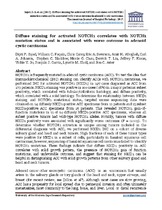| dc.contributor.author | Sajed, Dipti P. | |
| dc.contributor.author | Faquin, William C. | |
| dc.contributor.author | Carey, Chris | |
| dc.contributor.author | Severson, Eric A. | |
| dc.contributor.author | Afrogheh, Amir H. | |
| dc.contributor.author | Johnson, Carl A. | |
| dc.contributor.author | Blacklow, Stephen C. | |
| dc.contributor.author | Chau, Nicole G. | |
| dc.contributor.author | Lin, Derrick T. | |
| dc.contributor.author | Krane, Jeffrey F. | |
| dc.contributor.author | Jo, Vickie Y. | |
| dc.contributor.author | Garcia, Joaquín J. | |
| dc.contributor.author | Sholl, Lynette M. | |
| dc.contributor.author | Aster, Jon C. | |
| dc.date.accessioned | 2018-10-31T13:21:24Z | |
| dc.date.available | 2018-10-31T13:21:24Z | |
| dc.date.issued | 2017 | |
| dc.identifier.citation | Sajed, D. S. et. al. (2017). Diffuse staining for activated NOTCH1 correlates with NOTCH1 mutation status and is associated with worse outcome in adenoid cystic carcinoma. The American Journal of Surgical Pathology, 2017. | en_US |
| dc.identifier.issn | 0147-5185 | |
| dc.identifier.uri | http://hdl.handle.net/10566/4175 | |
| dc.description.abstract | NOTCH1 is frequently mutated in adenoid cystic carcinoma (ACC). To test the idea that immunohistochemical (IHC) staining can identify ACCs with NOTCH1 mutations, we performed IHC for activated NOTCH1 (NICD1) in 197 cases diagnosed as ACC from 173 patients. NICD1 staining was positive in 194 cases (98%) in 2 major patterns: subset positivity, which correlated with tubular/cribriform histology; and diffuse positivity, which correlated with a solid histology. To determine the relationship between NICD1 staining and NOTCH1 mutational status, targeted exome sequencing data were obtained on 14 diffusely NICD1-positive ACC specimens from 11 patients and 15 subset NICD1-positive ACC specimens from 15 patients. This revealed NOTCH1 gain-of-function mutations in 11 of 14 diffusely NICD1-positive ACC specimens, whereas all subset positive tumors had wild-type NOTCH1 alleles. Notably, tumors with diffuse NICD1 positivity were associated with significantly worse outcomes (P = 0.003). To determine whether NOTCH1 activation is unique among tumors included in the differential diagnosis with ACC, we performed NICD1 IHC on a cohort of diverse salivary gland and head and neck tumors. High fractions of each of these tumor types were positive for NICD1 in a subset of cells, particularly in basaloid squamous cell carcinomas; however, sequencing of basaloid squamous cell carcinomas failed to identify NOTCH1 mutations. These findings indicate that diffuse NICD1 positivity in ACC correlates with solid growth pattern, the presence of NOTCH1 gain of function mutations, and unfavorable outcome, and suggest that staining for NICD1 can be helpful in distinguishing ACC with solid growth patterns from other salivary gland and head and neck tumors. | en_US |
| dc.language.iso | en_US | en_US |
| dc.publisher | Lippincott, Williams & Wilkins | en_US |
| dc.subject | notch signaling | en_US |
| dc.subject | notch mutations | en_US |
| dc.subject | adenoid cystic carcinoma | en_US |
| dc.subject | next-generation sequencing | en_US |
| dc.title | Diffuse staining for activated NOTCH1 correlates with NOTCH1 mutation status and is associated with worse outcome in adenoid cystic carcinoma | en_US |
| dc.privacy.showsubmitter | FALSE | |
| dc.status.ispeerreviewed | TRUE | |

